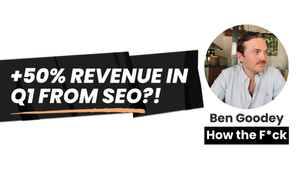I got off the phone with a client yesterday with a biiiig smile on my face.
They had good news to share.
“Your hard work is paying off”.
And much more than expected. They’d literally had 14 new prospect calls last Tuesday 🙃
Business revenues in Q1 2024 were +50% compared to the year before—and SEO was the driving force.
I’ve been working with this client since November.
And in just 6 months, SEO is driving serious revenue results.
So, reflection time.
In this week’s newsletter, I’m gonna dive into the details behind how I set up and executed this strategy and the lessons I’ve learned so far.
Background:
- Industry: Financial Services (e.g. accounting services)
- Timeframe: 6 months
- Existing non-brand traffic: 0
- Current non-brand traffic: ~2,000/mo
- Leads: +30 meetings book per month
- Revenue results: +50% revenue
1. We started with a brand new website. Here’s what we did first.
This was the first completely new site I’d worked on in a looooong time.
We started with customer, company, and keyword research, but then spent the first 4 weeks checking off everything on my new site checklist:
I was particularly concerned about fixing three areas:
- Good quality bottom-of-funnel pages
The overarching mechanism behind SEO is to send organic traffic to Service Pages. Either directly by ranking them in Google, or indirectly via a related blog post.
But those service pages are where people actually convert, so if they are poorly conversion-optimized you’ll always have a bottleneck.
So, step one with this client was to completely overhaul the site design.
We got a fresh template implemented with social proof, a compelling offer, clear copy, and an easy-to-navigate site architecture.
- A blog post template that makes content pop
If you’re a long-term follower, you’ll know I’m a big believer in design and UI in general.
I don’t want to spend endless hours perfecting content quality if the blog template (the content’s “wrapper”) puts the reader off before they even start reading.
So we created a new blog template in month one, too. Most of my thoughts on this topic can be found in my SEO blog template checklist here.
- A strong domain authority foundation
As a pre-SEO website, the Ahrefs domain rating was an extremely low 0.3.
Usually, if I’m working with clients they’ve got at least 30 or higher, so I worry first about content and then about backlinks to fuel the fire.
But we had just 0.3. I knew it’d be hard and slower to rank with such low authority.
I know people like to see movement quickly or they worry—and that’s completely fair enough—so, I didn’t want the results to be slow.
So, I paid particular attention to links from day one.
Result: We’re now at DR 25 and I’m feeling WAY more comfortable with that.
To get here I did two things:
- Pulled in a few favors from site owners to get some quality niche-edit links
- Looked around for free links from directories like Crunchbase
We also:
- Redirected a couple of aged domains the owner had purchased previously.
- Have started two digital PR campaigns (but only very recently—so the results are still TBC) with a partner
2. Audience Research & Keyword Strategy
Preparation:
Month one also covered two bases that helped us start producing content in month two:
- Thorough company, product, and audience analysis
- In-depth keyword research
Those of you who purchased my Scale Package have access to a key part of my “research” process—the internal guide questionnaire:
All my new clients fill out answers to things like:
- List your products/services in priority order here according to what you sell most or want to sell more.
- What was the last prospect/company that you had a really easy time closing? What was the problem that person was trying to solve?
They all help me, as the strategist, understand:
- What they sell
- Who they sell to
- How they sell it
- The business goals
This is an essential step that allows me to build a strategy that will drive the right outcomes.
Keyword strategy:
Because this was a new website, it also meant there was no topical authority.
With some sites, I focus 100% on bottom-of-funnel content—it has the best conversion potential.
But on a brand new site?
I deployed a three-pronged strategy:
- The first content cluster
Most SEOs will recommend you build all your content in topic clusters (groups of semantically related content that have internal links to each other).
I’d recommend this as well. But I often leave top-of-funnel content (e.g. “What is X?”) out of each cluster.
Whatever you choose to do, always, always ask yourself “Would MY target audience search for this?” and if it’s a no—don’t write it.
It may be top of funnel for someone, but if your audience wouldn’t search for it then it’s not even in your funnel.
Now, back to: the first cluster.
I treat the first cluster as special.
The topic should be all around your core business service. The one you want prioritize selling more.
For this first cluster, then create a topical map and content that covers the topic entirely. All the nuances.
The goal is to build awareness and presence for the business area you want to be most known for—so whatever question someone has, they will always find you.
With other clusters, I focus 90% of new content on middle and bottom-of-funnel topics that show a real intent to purchase. This is most efficient for performance.
But that first cluster? I treat it like a big brand effort.
- Avalanche SEO Content
Avalanche SEO is essentially the technique of starting with low-volume, low-competition keywords that your site can win, and, as you gain traffic and authority, slowly building up to higher-volume, higher-competition keywords.
This is what I did with this client.
We had DR 0.3 and no traffic. So the first blog post wasn’t “20,000 monthly visitors” it was:
- Several high-intent keywords we wanted to give more time to rank
- Several low-volume, low-competition keywords we could immediately rank in the top 10 for
As the site grows, we’ll be taking on more competitive opportunities in a snowball-like fashion.
- Rank Your Service Pages
It’s best practice to target a term like “sales software” with a listicle like “Top 10 Sales Software in 2024”.
However, if the term “sales software” wasn’t very competitive, it’s possible to win it with a Service Page that focuses 100% on…you…and still rank #1.
With this client, I’m following a variation of this approach and a few other techniques to rank them #1 for key bottom-of-funnel terms.
3. Quality Content Production
As month two came around, we had:
- A strong site, UI design, and foundation in place
- A keyword plan for the next 6+ months
- Steadily growing backlink profile
Now, it was time to start writing content.
I work with a handful of carefully vetted freelancers. The kind who really “get it”.
Together, we produce 4 articles a month and ~4 landing/service pages.
That’s a relatively small amount of content. But it paid off massively because we were hyper-targeted and increased quality a lot.
My monthly workflow with writers looks like this:
- I create in-depth content briefs. They’re fully researched, 2000+ word articles, all baked with SEO best practices to ensure they rank. The priority is always: how valuable can we make this to the reader? The founder I work directly with is a niche expert, so we’ll often ask him for expert input.
- The writer does their magic. They write using guidelines of “simple language” and “actionable, useful content”.
- I edit the content and place it live. I love editing content. If you take time over it you can really level up an article. I also spend a lot of time improving “design”—for example, lists get put in accordion boxes within the WordPress blog template.
This org chart comes from my book on Producing Content at Scale. When the content volumes are low, an individual can cover multiple roles successfully.
It’s so key when growing your site to consistently publish good content. You’re giving Google the signals, and you want them to be the right ones.
Alongside this blog content, I’m always hunting down and publishing new Service Pages (for example, sets of keywords like “finance X service in X location” which are super low volume but nobody else is targeting them).
Key Results
- +20 articles
- +15 service pages
- 0 to 2,000 organic visitors/month
- From DR 0.3 to DR 25
Where Next?
The plan continues:
- More content around new service areas
- Building partnerships with others to earn backlinks
- Focused links on key service areas
The most key part of the success so far: working with a client who is available when we need him, also wanting to drive the success, but equally lets us do our job.
It’s been a joy to work on 🥰


